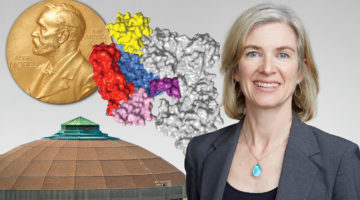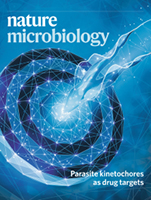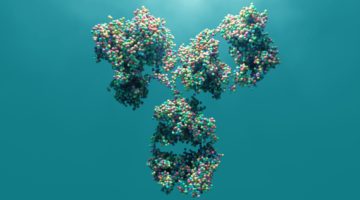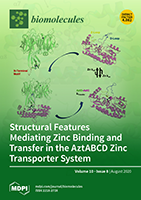We investigated the mechanism of action of antifungal drugs in the human pathogen Acanthamoeba castellanii. We discovered that the enzyme target formed a dimer via an N-termini swap, whereas drug-bound AcCYP51 was monomeric. Cover image shows a molecular model of the AcCYP51 dimer in a phospholipid bilayer. Read more »
Experimental Drug Targets HIV in a Novel Way
Researchers from Gilead Sciences Inc. solved the structure of an experimental HIV drug bound to a novel target: the capsid protein that forms a shield around the viral RNA. The work could lead to a long-lasting HIV treatment that overcomes the problem of drug resistance and avoids the need for burdensome daily pill-taking. Read more »![]()
![]()
Jennifer Doudna and the Nobel Prize: The Advanced Light Source Perspective
The 2020 Nobel Prize in Chemistry was awarded to Jennifer Doudna and Emmanuelle Charpentier for the development of a world-changing gene-editing technology. At the ALS, Doudna’s work on CRISPR-Cas9 was enabled by many visionary people with innovative ideas, implemented in support of a world-class structural biology program. Read more »![]()
Study Finds ‘Missing Link’ in the Evolutionary History of Carbon-Fixing Protein Rubisco
Scientists discovered an ancient form of rubisco, the most abundant enzyme on Earth and critical to life as we know it. Found in previously unknown environmental microbes, the newly identified rubisco provides insight into the evolution of the photosynthetic organisms that underlie the planet’s food chains. Read more »
Targeting the trypanosome kinetochore with CLK1 protein kinase inhibitors
Saldivia et al. identify CLK1 as the target for the amidobenzimidazoles series of compounds. Inhibition of this protein kinase impairs inner kinetochore recruitment, causing cell-cycle arrest and cell death in trypanosomal pathogens such as Trypanosoma brucei. Read more »
Providing New Technologies for Vaccine Development
Antigens can sometimes be attached to a protein scaffold to mimic the shape of a virus and elicit a stronger immune response. Scientists developed a method to design such proteins, and ALS data helped to visualize the atomic structure and determine the dynamics of the designed scaffolds. Read more »
Missing Lysine Link Could Improve Plant-Based Nutrition
To engineer crops with higher levels of the important amino acid, lysine, researchers solved the structure of an enzyme that helps break down lysine in plants. A fuller understanding of the factors affecting lysine levels should aid in the successful development of stable high-lysine crops to combat malnutrition globally. Read more »
How Proteins Remodel DNA in Bacteria under Stress
Multiscale, multimodal visualization techniques at the ALS enabled researchers to clarify how proteins remodel bacterial DNA in response to stressful environments. The discovery could lead to new strategies for controlling microbial behavior and, eventually, new ways to fight bacterial infections. Read more »![]()
![]()
Toughening Mechanisms in Carp Scales at the Nanoscale
Scientists have characterized carp scales down to the nanoscale, using the ALS to watch how the fibers in the scales react as stress is applied. The resulting insights provide inspiration for the design of advanced synthetic structural materials with unprecedented toughness and penetration resistance. Read more »![]()
![]()
Structural Features Mediating Zinc Binding and Transfer in the AztABCD Zinc Transporter System
Zinc homeostasis is critical for bacterial survival and virulence. Extracellular zinc-binding proteins play an important role in this process. This work assesses the role of several flexible or unstructured sequences in zinc binding and transfer from proteins AztD to AztC. The results provide insights into the dynamic nature of these processes and support a previously proposed structural model of transfer. Read more »
- « Previous Page
- 1
- …
- 8
- 9
- 10
- 11
- 12
- …
- 24
- Next Page »









